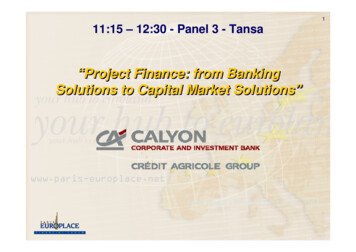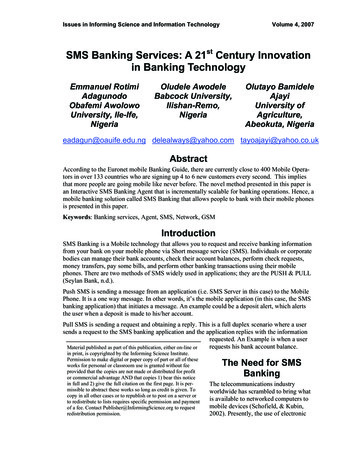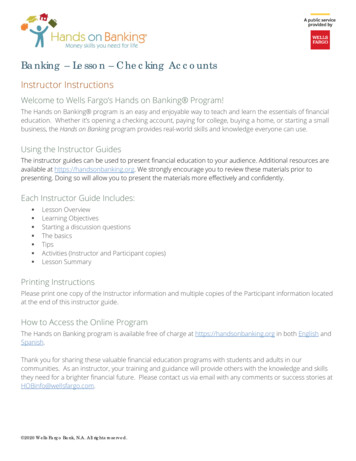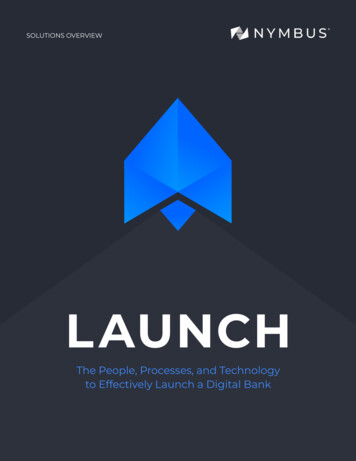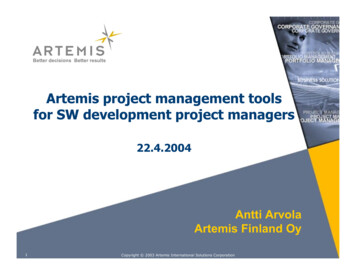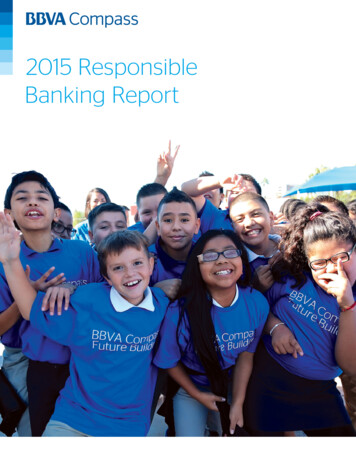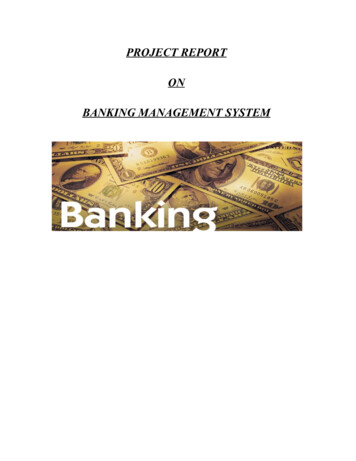
Transcription
PROJECT REPORTONBANKING MANAGEMENT SYSTEM
TABLE OFCONTENTS Abstract of the Project System Requirements Product Definition Feasibility Analysis Project Plan System requirements specification Developing/Operation/MaintenanceEnvironments External Interface and data Flows Functional and performance Specifications Design
Detailed DFDs Data structure, Database and File Specifications. Project Legacy Current status of project Remaining areas of concern Technical and managerial lessons learnt Future recommendations Source code Scope of the Project Bibliography and ReferencesABSTRACT OF THE PROJECTAs we are beginners and have no practical experience in thefield of software development and moreover the BankingSystem is very wide. So, we limit the scope of our project bycomputerizing the following fields of the Banking System: - Account Opening. Daily Transactions.
Loan Sanctions. Account Maintenance. Search:1.Searches record of a particular Account Holder.2.Searches the record for a each type of Account(s).I.Savings AccountII.Current AccountIII.Fixed Deposit AccountIV.Recurring Deposit AccountV.Loan Account3.Searches the record of a particular organization’sAccount Holders.SYSTEM REQUIREMENTS PRODUCT DEFINITION:We have come to finalconclusion that after analyzing the existing system of the
“Solitaire Software”. We came to know that it is verydifficult for the person to maintain records manually samein the case with the person who is maintaining Books LikeLedgers etc., so in order to provide the bank with such asystem that helps them easy in maintaining the records ofthe customers, we are going with this project. Theoperations performed by this project are maintenance theinformation of the Customers that are dealing with thebank. PROBLEM STATEMENT:- Data redundancy and inconsistency. Difference in accessing data. Data isolation. Security problem Communication gap Updating problem FUNCTIONALITY TO BE PROVIDED:-
Maintenance of Account Holder’s records those areavailable in the Books. Maintenance of Daily Transactions that are ongoing inthe Bank. Maintenance of Different Accounts for the annualclosing of Accounting Books. Searching Criterion. Maintenance of the reports. PROCESSING ENVIRONMENT-HARDWARE ANDSOFTWARE: - Operating system is a platform on which thespecified application will be used. Once it has beencomplete, the software we are about to make, willexecute on both client machine and server machine. Configuration:- O/S –Windows XP.
RAM – Min. 256 MB Networking enabled for clients, or database. SOLUTION STRATEGY:- Classical Life Cycle Model:-Thisisasequentialapproach to software development. It begins withanalysis and progresses through design, coding,testing & maintenance. Analysis:To understand the nature of the programto build, the analysts must know the g.These requirements are found by interleaving theCustomerandaskingregarding their needs. Design:-themvariousquestions
This process translates the requirementinto a representation that can be accessed beforeputting into actual code, design includes the followingactivities:1. Algorithm2. Logical Design Flow Charts3. Physical Design4. Database Design Coding:The design is then translated into actualmachine language using appropriate language. Testing:The design is then translated in written,testing begins, the testing focus on the checkingthe logic if the code, intervals of the software touncover errors so that the code produces theactual result. Maintenance:-
Maintenanceisdoneafterthesoftware has been installed at the user site. Aserror bound to occur so changes has to be done tomeet the user needs. ACCEPTANCE CRITERIA:- Computerize maintenance of records. Maintain Account Holder’s information. Maintain the records of the Daily Transactions inthe bank. Maintain various reports( i.e. Account Statements). FEASIBILITY ANALYSIS:-Depending on the resultsof the initial investigation, the survey is expanded to amore detailed feasibility study. A feasibility study is atest of a system proposal. According to its workability,impact on the organization, ability to meet user’s needs
and effective use of the resources its main task doneduring the feasibility study are:-1. Evaluation of existing system and procedures. Ourgroup went to various Banking Professionals togather information about the software system. Theyare using and evaluating those system and ty study.2. Analysis of alternative candidate systems afterstudying the various systems we derived variousalternatives through which we develop our projectand evaluated the alternative. The most appropriateis selected. ECONOMIC FEASIBILITY:-
Theonlytangiblebenefitprovided by the proposed system is that the paper workis reduced to the minimum and hence the reduction incost incurred on Stationary and its storage. The systemprovides many benefits that can’t be measured in sponse being more efficient. TECHNICAL FEASIBILITY:The proposed system istechnically feasible as it can be developed easily withthe help of available technology. The proposed systemrequires MS – VISUAL Studio 2005 using VB.Net as aInterface for Programming & back-end as MS-SQLServer 2000 for storing/maintaining database. Thedatabase can be easily interconnected using MS-SQLServer 2000. OPERATIONAL FEASIBILITY:Automationmakesourlife easy. The proposed system is highly user friendly
and is much easily able to interact with the system.Therefore the users will readily accept the system asdata entry and making queries can be easily done. PROJECT PLAN:- TEAM STRUCTURE AND SIZE:- For developing this project, our team structureconsist 3 members as mentioned above. Each member has devoted his efforts toward theachievement for this project. The whole project is divided among us, so thatfunctionality can be achieved. DEVELOPMENT SCHEDULE:-As per college requirements and infrastructure, ourteamhasdevotedmaximumdevelopment of the project.timeforthe
PROGRAMMING LANGUAGE, DEVELOPMENT TOOLS(FRONT-END AND BACK-END): Front-End: - Visual Studio 2005 Back-End: - MS-SQL Server 2000.
VISUAL PROGRAMMING Visual programming aims at providing the user with aninterface that is intuitive and easy to use. In developingsuch an interface, the programmer employs user-friendlyfeatures such as windows, menus, buttons and list boxes. Its Environment provides all features that are requiredto develop a graphical user interface as ready -to- usecomponents. The programmer does not have to write codeto create and display commonly required user-friendlyfeatures each time around. When the programmer needs a specific user interfacefeature such as button, he selects the appropriate readyto-use component provided by the visual programmingenvironment. These components can be moved, resizedand renamed as required.
For Example:-If theprogrammer needs to have abutton then the visual programming environment provideshim with one. All that, the programmer does this selectthe button and place it on screen at the required position. Typically the mouse is used to select and place thenecessary components. Thus, the visual programmingenvironment is also called a point and click environment. A visual programming environment automates theprocess of creating a user interface. The interface rammer designs the user interface visually instead ofwriting code.
In addition it also provides a means of associating codewith each component. In each case of calculator, for eachbutton, we can specific that the code is to execute whenwe click on it.NEED FOR VISUAL PROGRAMMING:- There are several programming tools that allow us tobuild such visually appealing and intuitive interface. Thesetools allow us to design interface that employ user friendlyfeatures such as menus, buttons, windows etc. However, the disadvantage of such tools is that theinterface is designed using code. The programmer has tocode the user interface features specifying the size,position etc. this makes designing the user interface amajor task in itself.
ADVANTAGES OF VISUAL PROGRAMMING:- Visual development of graphical user interface whichare easy to use and easy to learn. A programmer need not write code to display therequired component. For Example:-
Thevisualprogrammingenvironmentdisplays a list of available components. The programmerpicks up the required component from this list to displayit. The component can be moved, resized and evendeleted, if so required. There is no restriction on the number of controls thatcan be placed on a form. ng environment have some code built intothem.
For example:-A button’ knows’ when it has been clickedupon. In the case of conventional programming tools, theprogrammerhastowritecodetodeterminethecomponent that has been clicked and then execute theappropriate code. Some popular Visual Programming tools are:- Visual basis.net 2005 Power builder Developer 2000 Visual Basic is one of the most popular programmingtools available today. And it’s also secret that there havebeen massive changes in it as it became Visual Basic.Net.
The reason of that change is Visual Basic itself, whichhas now become Visual Basic.Net. The difference betweenVisual Basic.Net and the previous version. Visual Basic 6.0is revolutionary and far reaching. Visual Basic.Net hasbeen more than four years in the marking and itrepresents entirely new directions for Visual Basic. lopment the very syntax, of techniques that you’veprobably learned carefully are now completely differentsuch as data handling and many controls; project typesand other aspects of Visual Basic 6.0 are no longeravailable at all. Visual Basic has a long and so far glorious history.When it first appeared, it created a revolution in windowsprogramming. Visual Basic introduced unheard of ease towindows programming just builds the program you wantright before your eyes, and then run it. In so doing itchanged programming form a chore to something very likefun.
There are two visual styles available in V.B. IDE that are:- SDI (Single Document Interface). MDI (Multiple Document Interface)
INTRODUCTION TO VISUAL STUDIO .NET Microsoft’s .NET initiative is broad-based and sses the languages and execution platform, nctionality. Besides the core .NET framework, the .NETinitiative includes protocols (such as Simple Object AccessProtocol-SOAP) to provide a new level of s/w integrationover the Internet via standard net services. The first release product based on .NET framework wasVisual Studio 2002. BROAD AND DEEP PLATFORM FOR THE FUTURE:-
.NET framework encompasses a virtual machine vironmentAPIsupportsfrommultiplelanguages. The vision of Microsoft .NET is globallydistributed systems, using XML as universal glue to ganization or across the world. DIFFICULTIES WITH DNA AND COM:ThePre.NETtechnologies used for development on Microsoft modelforforcreationmultitierarchitectures. These standards had some drawbacks. Difficulty in integrating Internet technologies.ofs/w
Lack of full object orientation. One threading model. Poor integration with Internet. Poor error handling.
OVERVIEW OF .NET FRAMEWORK.NET is a framework that covers all the layers s/w developmentabove the operating system. It provides the richest mponent technologies and data technologies ever seenon a Microsoft platform. The entire architecture has beencreated to make it easy to develop internet applications,as it is to develop for the desktop.VS.NET supports Windows 2003,Windows XP and all versions ofWindows 2000.Programs created for .NET can also rununder Windows NT, Windows 98, and Windows Me, thoughVS.NET doesn’t run on the system.
MAJOR COMPONENTS OF .NET FRAMEWORK: - ASP.NET (Web Services, Web forms, Asp.Net applicationServices). WINDOWFORMS(Controls,Drawing,Windowapplication Services). NET FRAMEWORK BASE CLASSES (ADO. Net, XML,Threading, IO, Component model, Security, Diagnostics,etc.). COMMON LANGUAGE RUNTIME (Memory Management,Common type System, Lifecycle Monitoring).The framework starts all the way down at the memorymanagement and component loading level, and goes all theway up to multiple ways of rendering user and programinterfaces.
CLR (Common Language Runtime):The CLR managesthe execution of code on .NET platform .The functionalityexposed by CLR is available to all .NET languages. LanguageRuntimes go back further than DOS languages. Its mainparts are: - Common type System Intermediate Language to Native code compilers. Execution support. Security. Garbage Collection, Stack walk, Code Manager. Class Loader and Memory layout.
THE DESIGN OF CLR IS BASED ON FOLLOWING GOALS:-1. Simple Faster Development.2. Automatic handling of system level task.3. Excellent Tool support.4. Simple safer deployment.5. Scalability.XML AS .NET META LANGUAGE: Much of the Underlyingintegration of .Net is accomplished with XML. Web Servicesdepend completely on XML for interfacing with RemoteObject. ADO.Net is dependent on XML for representations ofRemote Data. When ADO.NET creates data set .The data isconverted to XML for manipulation by ADO.NET.
INTRODUCTION TO VB.NET & VS.NET: -SOLUTION EXPLORER: On right side of VS.NET isSolution explorer. It provides a central location for all thefiles in your Project.NAMESPACES: - Namespace is a way of organizingclasses,Str
Evaluation of existing system and procedures. Our group went to various Banking Professionals to gather information about the software system. They are using and evaluating those system and the procedures invoked in it during the period of feasibility study. 2. Analysis of alternative candidate systems afterFile Size: 2MBPage Count: 154Explore further(PDF) Bank Account Management System - ResearchGatewww.researchgate.net(DOC) 54024405-project-report-banking-management-system .www.academia.eduBank Management System Project report - FREE DOWNLOAD .sites.google.comBANK MANAGEMENT SYSTEM PROJECT REPORT WITH SOURCE COD sites.google.comBank Management system - IRJETwww.irjet.netRecommended to you based on what's popular Feedback
